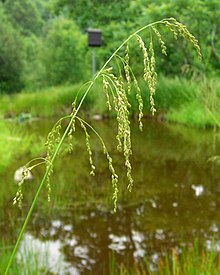Striped swath
| Striped swath | ||||||||||||
|---|---|---|---|---|---|---|---|---|---|---|---|---|

Striped plume ( Glyceria striata ) |
||||||||||||
| Systematics | ||||||||||||
|
||||||||||||
| Scientific name | ||||||||||||
| Glyceria striata | ||||||||||||
| ( Lam. ) Hitchc. |
The striped swath ( Glyceria striata ), also called striped sweet grass , is a type of plant from the genus swath ( Glyceria ) and thus of the sweet grass family (Poaceae).
description
The striped swath is persistent and forms dense clumps. It develops subterranean runners. Its stalks reach heights of 30–100 cm, they are erect or ascending and have 4–6 bare knots. The leaf blades are up to 20 cm long and 2–6 mm wide. The ligule is 1.5-3 mm long. The flower panicle is 5–30 cm long, loose, spread out at maturity and often nodding. The lower side branches go to 1–2 from the main axis and are only covered with spikelets in the upper half. The spikelet pedicels are 1–2 mm long. The spikelets are 4-7-flowered, 2–4 mm long, laterally compressed, ovate. When ripe, the florets fall individually from the glumes that have remained standing. The glumes are lanceolate to ovate and rounded. The lemmas are seven-veined, 1.5–2 mm long, membranous, with a whitish-transparent upper margin. The palea are two-veined and slightly shorter than the lemma. The florets contain two, very rarely three stamens. The anthers are 0.4-0.6 mm long. The flowering period is July to August.
The number of chromosomes is 2n = 20.
distribution
The original distribution area of the Striped Swath extends from sub-Arctic America south to Guatemala. In France, Sweden, the Czech Republic, Poland, Austria, Switzerland, Germany and New Zealand the species is a neophyte.
Spread history
In Europe, the species was first observed in France in 1849. Further observations were not made until 100 years later. The species was discovered in Switzerland in 1952, in Austria in 1966, in Liechtenstein in 1972, in Poland in 1981. Henning Haeupler discovered the species in Germany in 1971 on the Dinkelberg near Degerfelden . The introduction into Germany probably took place with American seeds already before the Second World War.
ecology
The species grows in Central Europe, especially on wet forest paths in societies of the Agropyro-Rumicion association, but also in those of the Alliarion association. In Central Europe, it often occurs on cultivated bog areas, on wet pastures or on fallow meadows. The soils are often wet, acidic bog soils.
Taxonomy
The species was first described by Jean-Baptiste de Lamarck as Poa striata in Tabl. Encycl. 1: 183 (1791). Albert Spear Hitchcock got them in Proc. Biol. Soc. Washington 41: 157 (1928) placed in the genus Glyceria .
literature
- Hans Joachim Conert: Glyceria . In: Gustav Hegi : Illustrated flora of Central Europe . 3rd ed., Volume I, Part 3, pages 451-453. Verlag Paul Parey, Berlin, Hamburg, 1987. ISBN 3-489-52320-2 (description, history of expansion)
Individual evidence
- ↑ a b Erich Oberdorfer : Plant-sociological excursion flora for Germany and neighboring areas . With the collaboration of Angelika Schwabe and Theo Müller. 8th, heavily revised and expanded edition. Eugen Ulmer, Stuttgart (Hohenheim) 2001, ISBN 3-8001-3131-5 , pp. 218-219 .
- ↑ a b Rafaël Govaerts (Ed.): Glyceria striata. In: World Checklist of Selected Plant Families (WCSP) - The Board of Trustees of the Royal Botanic Gardens, Kew . Retrieved June 8, 2020.
Web links
- Glyceria striata (Lam.) Hitchc., Swaths. In: FloraWeb.de.
- Entry at bayernflora.de
- Thomas Meyer: Data sheet with identification key and photos at Flora-de: Flora von Deutschland (old name of the website: Flowers in Swabia )
